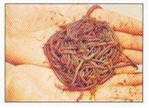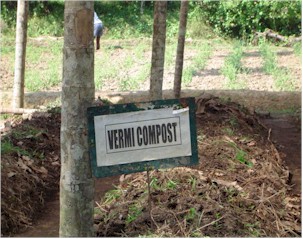|
|
 |
 |
 |
Vermiculture means artificial rearing or cultivation of worms (Earthworms) and the technology is the scientific process of using them for the betterment of human beings. Vermicompost is the excreta of earthworm, which is rich in humus. Earthworms eat cow dung or farm yard manure along with other farm wastes and pass it through their body and in the process convert it into vermicompost. The municipal wastes; non-toxic solid and liquid waste of the industries and household garbage’s can also be converted into vermicompost in the same manner. Earthworms not only convert garbage into valuable manure but keep the environment healthy. Conversion of garbage by earthworms into compost and the multiplication of earthworms are simple process and can be easily handled by the farmers.
Method of preparation of Vermicompost Large/community Scale Vermicomposting Methodology
A thatched roof shed preferably open from all sides with unpaved(katcha) floor is erected in East-West direction length wise to protect the site from direct sunlight. A shed area of 12’X12’ is sufficient to accommodate three vermibeds of 10’X3’ each having 1’ space in between for treatment of 9-12 quintals of waste in a cycle of 40-45 days. The length of shed can be increased/decreased depending upon the quantity of waste to be treated and availability of space. The height of thatched roof is kept at 8 feet from the centre and 6 feet from the sides. The base of the site is raised atleast 6 inches above ground to protect it from flooding during the rains. The vermibeds are laid over the raised ground as per the procedure given below.
The site marked for vermibeds on the raised ground is watered and a 4”-6” layer of any slowly biodegradable agricultural residue such as dried leaves/straw/sugarcane trash etc. is laid over it after soaking with water. This is followed by 1” layer of Vermicompost or farm yard manure.
Earthworms are released on each vermibed at the following rates :
For treatment of cowdung/agriwaste : 1.0 kg. per
For treatment of household garbage : 1.5 kg. per
The frequency and limits of loading the waste can vary as below depending upon the convenience of the user
| Frequency | Loading |
| Daily | 2" /bed/day |
| In Bulk | 12-15"(3-4q/bed/cycle of 45 days) |
The loaded waste is finally covered with a Jute Mat to protect earthworms from birds and insects.Water is sprinkled on the vermibeds daily according to requirement and season to keep them moist.The waste is turned upside down fortnightly without disturbing the basal layer (vermibed).The appearance of black granular crumbly powder on top of vermibeds indicate harvest stage of the compost. Watering is stopped for atleast 5 days at this stage. The earthworms go down and the compost is collected from the top without disturbing the lower layers (vermibed). The first lot of Vermicompost is ready for harvesting after 2-2 ˝ months and the subsequent lots can be harvested after every 6 weeks of loading.The vermibed is loaded for the next treatment cycle.
Multiplication of worms in large scale
Prepare a mixture of cow dung and dried leaves in 1:1 proportion. Release earthworm @ 50 numbers/10 kg. Of mixture and mix dried grass/leaves or husk and keep it in shade. Sprinkle water over it time to time to maintain moisture level. By this process, earthworms multiply 300 times within one to two months. These earthworms can be used to prepare vermicompost.
Advantages of Vermicomposting
Vermicompost is an ecofriendly natural fertilizer prepared from biodegradable organic wastes and is free from chemical inputs.
It does not have any adverse effect on soil, plant and environment.
It improves soil aeration, texture and tilth thereby reducing soil compaction.
It improves water retention capacity of soil because of its high organic matter content.
It promotes better root growth and nutrient absorption.
It improves nutrient status of soil-both macro-nutrients and micro-nutrients.
Precautions
Vermicompost pit should be protected from direct sun light.
To maintain moisture level, spray water on the pit as an when required.
Protect the worms from ant, rat and bird
Nutrient Profile* of Vermicompost and Farm Yard Manure
|
Nutrient |
Vermicompost |
Farm Yard Manure |
|
N(%) |
1.6 |
0.5 |
|
PO(%) |
0.7 |
0.2 |
|
KO(%) |
0.8 |
0.5 |
|
Ca(%) |
0.5 |
0.9 |
|
Mg(%) |
0.2 |
0.2 |
|
Fe(ppm) |
175.0 |
146.5 |
|
Mn(ppm) |
96.5 |
69.0 |
|
Zn(ppm) |
24.5 |
14.5 |
|
Cu(ppm) |
5.0 |
2.8 |
|
C:N ratio |
15.5 |
31.3 |
* These values are subject to variation depending upon the type of organic waste. Source: Punjab State Council for Science and Technology, Chandigarh